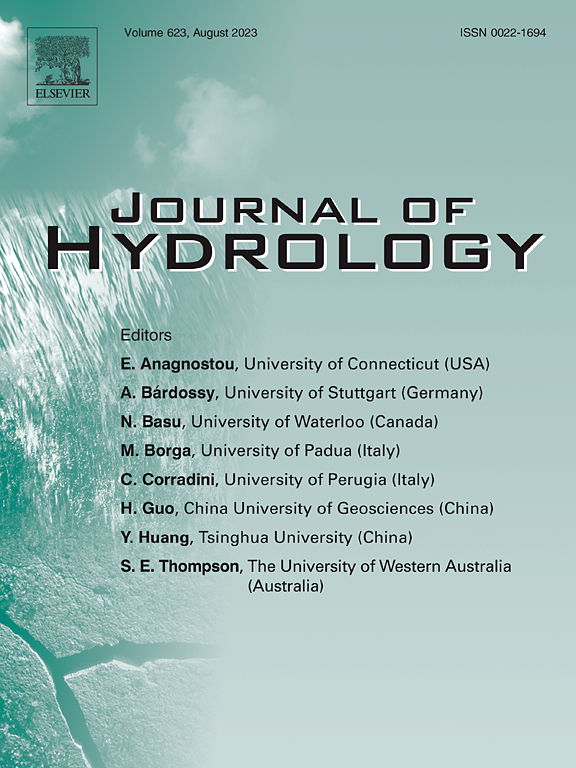Shapelet-based decomposition stack machine learning model explains more middle river reaches water level hydrological process with high accuracy early warning
IF 6.3
1区 地球科学
Q1 ENGINEERING, CIVIL
引用次数: 0
Abstract
Flooding remains one of the most devastating natural hazards worldwide, yet understanding the complex hydrological processes that lead to flooding poses a significant challenge, hindering effective prevention efforts. To address this issue, this study proposes a stacked machine learning framework that integrates the Offline Shapelet Discovery (OSD) technique. Hydrological time series data are first decomposed using Empirical Wavelet Transform (EWT), and OSD is applied to generate a pool of potential shapelets for training. These shapelets are then processed using a deep learning model to produce preliminary predictions. Finally, an ensemble machine learning approach integrates these sub-predictions to generate the final forecast. The model is evaluated in the Pearl River Basin, a representative watershed encompassing several major urban areas. Compared with traditional machine learning methods, the proposed model demonstrates superior predictive performance across six stations located in the upper, middle and lower reaches of the basin. In the upper reaches, the model achieves a mean absolute error (MAE) of 0.2265, mean square error (MSE) of 0.0723, root mean square error (RMSE) of 0.2679, mean absolute percentage error (MAPE) of 0.0038, percent bias (PBIAS) of 0.0034 and Nash-Sutcliffe efficiency (NSE) of 0.8103. In the lower reaches, the respective values are 0.1766, 0.0619, 0.2720, 0.0415, −0.0007 and 0.8739, while in the middle reaches, they are 0.1239, 0.0362, 0.1890, 0.0059, 0.0007 and 0.9228. The shapelet pool reveals distinctive water level patterns, notably “up-down-up-up” and “down-down-up-down” types across various river segments. This study contributes to a deeper understanding of complex hydrological behaviors and provides new insights for enhancing flood prediction and prevention strategies through innovative data decomposition and pattern recognition techniques.
基于shapelet的分解叠加机器学习模型更准确地解释了中游河流到达水位的水文过程
洪水仍然是世界范围内最具破坏性的自然灾害之一,但了解导致洪水的复杂水文过程构成了重大挑战,阻碍了有效的预防工作。为了解决这个问题,本研究提出了一个集成离线Shapelet发现(OSD)技术的堆叠机器学习框架。首先利用经验小波变换(Empirical Wavelet Transform, EWT)对水文时间序列数据进行分解,然后利用OSD生成潜在小波池进行训练。然后使用深度学习模型对这些shapelets进行处理,以产生初步预测。最后,集成机器学习方法集成这些子预测以生成最终预测。该模型在珠江流域进行了评估,珠江流域是一个包含几个主要城市地区的代表性流域。与传统的机器学习方法相比,该模型在位于流域上、中、下游的6个站点上显示出优越的预测性能。在上游,模型的平均绝对误差(MAE)为0.2265,均方误差(MSE)为0.0723,均方根误差(RMSE)为0.2679,平均绝对百分比误差(MAPE)为0.0038,百分比偏差(PBIAS)为0.0034,Nash-Sutcliffe效率(NSE)为0.8103。下游分别为0.1766、0.0619、0.2720、0.0415、−0.0007、0.8739,中游分别为0.1239、0.0362、0.1890、0.0059、0.0007、0.9228。形状池的水位形态明显,在不同的河段上呈现出“上-下-上-上”和“下-下-上-下”的形态。该研究有助于加深对复杂水文行为的理解,并通过创新的数据分解和模式识别技术为加强洪水预测和预防策略提供新的见解。
本文章由计算机程序翻译,如有差异,请以英文原文为准。
求助全文
约1分钟内获得全文
求助全文
来源期刊

Journal of Hydrology
地学-地球科学综合
CiteScore
11.00
自引率
12.50%
发文量
1309
审稿时长
7.5 months
期刊介绍:
The Journal of Hydrology publishes original research papers and comprehensive reviews in all the subfields of the hydrological sciences including water based management and policy issues that impact on economics and society. These comprise, but are not limited to the physical, chemical, biogeochemical, stochastic and systems aspects of surface and groundwater hydrology, hydrometeorology and hydrogeology. Relevant topics incorporating the insights and methodologies of disciplines such as climatology, water resource systems, hydraulics, agrohydrology, geomorphology, soil science, instrumentation and remote sensing, civil and environmental engineering are included. Social science perspectives on hydrological problems such as resource and ecological economics, environmental sociology, psychology and behavioural science, management and policy analysis are also invited. Multi-and interdisciplinary analyses of hydrological problems are within scope. The science published in the Journal of Hydrology is relevant to catchment scales rather than exclusively to a local scale or site.
 求助内容:
求助内容: 应助结果提醒方式:
应助结果提醒方式:


